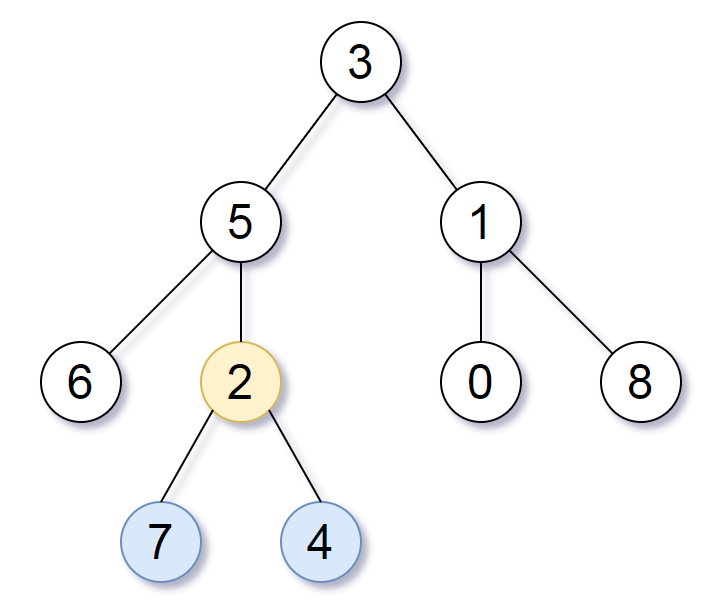- {x}
- Minimum Cost to Hire K Workers
- Mirror Reflection
- Buddy Strings
- Lemonade Change
- Score After Flipping Matrix
- Shortest Subarray with Sum at Least K
- All Nodes Distance K in Binary Tree
- Shortest Path to Get All Keys
- Smallest Subtree with all the Deepest Nodes
- Prime Palindrome
- Transpose Matrix
- Binary Gap
- Reordered Power of 2
- Advantage Shuffle
- Minimum Number of Refueling Stops
- Leaf-Similar Trees
- Length of Longest Fibonacci Subsequence
- Read More...

Smallest Subtree with all the Deepest Nodes
Given the root of a binary tree, the depth of each node is the shortest distance to the root.
Return the smallest subtree such that it contains all the deepest nodes in the original tree.
A node is called the deepest if it has the largest depth possible among any node in the entire tree.
The subtree of a node is a tree consisting of that node, plus the set of all descendants of that node.
Example 1:

Input: root = [3,5,1,6,2,0,8,null,null,7,4] Output: [2,7,4] Explanation: We return the node with value 2, colored in yellow in the diagram. The nodes coloured in blue are the deepest nodes of the tree. Notice that nodes 5, 3 and 2 contain the deepest nodes in the tree but node 2 is the smallest subtree among them, so we return it.
Example 2:
Input: root = [1] Output: [1] Explanation: The root is the deepest node in the tree.
Example 3:
Input: root = [0,1,3,null,2] Output: [2] Explanation: The deepest node in the tree is 2, the valid subtrees are the subtrees of nodes 2, 1 and 0 but the subtree of node 2 is the smallest.
Constraints:
- The number of nodes in the tree will be in the range
[1, 500]. 0 <= Node.val <= 500- The values of the nodes in the tree are unique.
Note: This question is the same as 1123: https://leetcode.com/problems/lowest-common-ancestor-of-deepest-leaves/
Solution Explanation: Smallest Subtree with all Deepest Nodes
This problem asks to find the smallest subtree containing all the deepest nodes in a given binary tree. The solution uses a depth-first search (DFS) approach to efficiently find this subtree.
Approach:
The core idea is to perform a post-order traversal of the tree. For each node, we need to know:
-
The depth of the subtree rooted at that node: This is calculated recursively by adding 1 to the maximum depth of its left and right subtrees.
-
The smallest subtree containing all deepest nodes of its subtree: This is the crucial part.
- If the left subtree is deeper than the right subtree, the smallest subtree is the result from the left subtree.
- If the right subtree is deeper, the smallest subtree is the result from the right subtree.
- If both subtrees have the same depth, the current node itself is the smallest subtree because it's the lowest common ancestor of all deepest nodes in its subtree.
Algorithm:
The dfs function recursively processes each node:
-
Base Case: If the node is
null, returnnull(no subtree) and depth 0. -
Recursive Step:
- Recursively call
dfson the left and right children to get their smallest subtrees (leftSubtree,rightSubtree) and their depths (leftDepth,rightDepth). - Compare
leftDepthandrightDepth:- If
leftDepth > rightDepth, the smallest subtree isleftSubtree, and the depth isleftDepth + 1. - If
leftDepth < rightDepth, the smallest subtree isrightSubtree, and the depth isrightDepth + 1. - If
leftDepth == rightDepth, the current node is the smallest subtree, and the depth isleftDepth + 1.
- If
- Recursively call
-
Return Value: The function returns a pair:
(smallestSubtree, depth).
The main function simply calls dfs(root) and returns the first element of the resulting pair, which is the smallestSubtree.
Time and Space Complexity:
- Time Complexity: O(N), where N is the number of nodes in the tree. We visit each node exactly once during the DFS traversal.
- Space Complexity: O(H), where H is the height of the tree. This is due to the recursive call stack. In the worst case (a skewed tree), H can be N, resulting in O(N) space complexity. However, for balanced trees, H is log(N), leading to O(log N) space complexity.
Code (Python):
class TreeNode:
def __init__(self, val=0, left=None, right=None):
self.val = val
self.left = left
self.right = right
def subtreeWithAllDeepest(root: TreeNode) -> TreeNode:
def dfs(node: TreeNode):
if not node:
return None, 0 # Return None subtree and depth 0 for empty subtree
left_subtree, left_depth = dfs(node.left)
right_subtree, right_depth = dfs(node.right)
if left_depth > right_depth:
return left_subtree, left_depth + 1
elif right_depth > left_depth:
return right_subtree, right_depth + 1
else:
return node, left_depth + 1
return dfs(root)[0]
The code in other languages (Java, C++, Go, TypeScript) follows the same logic, differing only in syntax. The key is the recursive dfs function and the handling of the different depth cases.